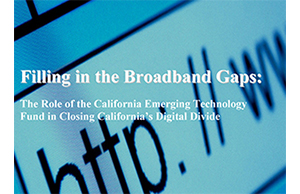Efforts to close the Digital Divide in California have been ongoing for more than a decade. In March of 2006, 84 million homes in the United States had broadband service. There still, however, is a large portion of the population that does not have home broadband. With a California focus, this paper surveys broadband usage statistics, seeks to understand why gaps in broadband coverage exists, and reviews five California programs including lessons learned.
A review of academic and market studies demonstrate that individuals who possess one or more of the following characteristics are less likely to have broadband in the home:
- Over age 65
- Household income less than $35,000
- No high school degree
- Resides in a rural area
- Non-English speaking or limited English proficient
- Disabled
While there are many potential explanations for why “gaps” in usage exist, these explanations essentially fall into three broad categories. These categories are as follows: (i) issues concerning access, (ii) issues concerning affordability, and (iii) issues concerning applications and content. Various projects have sought to close these three observed usage gaps by using a range of strategies to reach out to underserved populations. These projects have produced mixed results, but a review of all projects supports the following general conclusions:
- Goal setting is crucial to determine who and where you want to serve, how you want to
do so, and what resources are needed. - Strategic planning of initiatives to expand the use of broadband must be an iterative process, whereby strategies to expand the use of broadband in part are based upon results of prior efforts.
- Metrics for success must be established to determine whether goals are met.
- Public relations and outreach programs are critical to reaching underserved populations.
The projects’ successes and failures both may be useful to the California Emerging Technology Fund (CETF) Board, as it considers how to achieve its mandated purpose of ensuring ubiquitous broadband access throughout the state.

